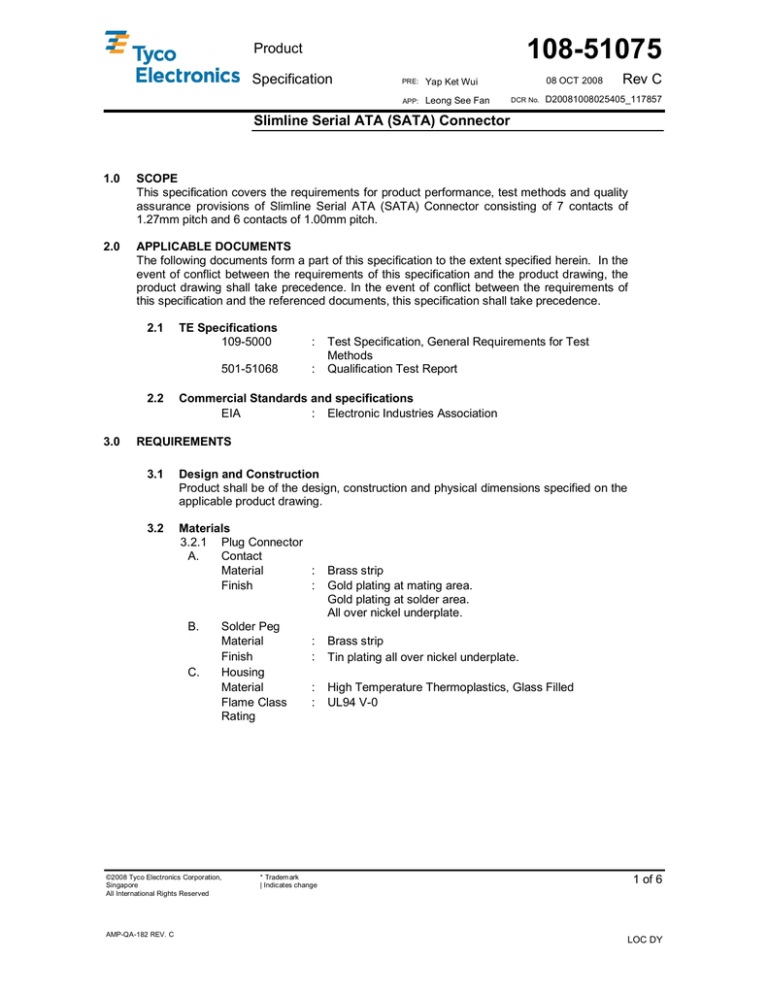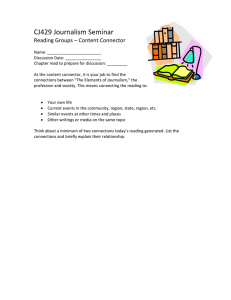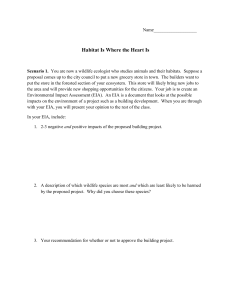
108-51075
Product
Specification
PRE:
Yap Ket Wui
APP:
Leong See Fan
08 OCT 2008
DCR No.
Rev C
D20081008025405_117857
Slimline Serial ATA (SATA) Connector
1.0
SCOPE
This specification covers the requirements for product performance, test methods and quality
assurance provisions of Slimline Serial ATA (SATA) Connector consisting of 7 contacts of
1.27mm pitch and 6 contacts of 1.00mm pitch.
2.0
APPLICABLE DOCUMENTS
The following documents form a part of this specification to the extent specified herein. In the
event of conflict between the requirements of this specification and the product drawing, the
product drawing shall take precedence. In the event of conflict between the requirements of
this specification and the referenced documents, this specification shall take precedence.
2.1
2.2
3.0
TE Specifications
109-5000
:
501-51068
:
Test Specification, General Requirements for Test
Methods
Qualification Test Report
Commercial Standards and specifications
EIA
: Electronic Industries Association
REQUIREMENTS
3.1
Design and Construction
Product shall be of the design, construction and physical dimensions specified on the
applicable product drawing.
3.2
Materials
3.2.1 Plug Connector
A.
Contact
Material
:
Finish
:
B.
C.
Solder Peg
Material
Finish
Housing
Material
Flame Class
Rating
©2008 Tyco Electronics Corporation,
Singapore
All International Rights Reserved
AMP-QA-182 REV. C
Brass strip
Gold plating at mating area.
Gold plating at solder area.
All over nickel underplate.
:
:
Brass strip
Tin plating all over nickel underplate.
:
:
High Temperature Thermoplastics, Glass Filled
UL94 V-0
* Tradem ark
| Indicates change
1 of 6
LOC DY
108-51075
3.2.2
A.
B.
C.
Receptacle Connector
Contact
Material
: Phosphor bronze strip
Finish
: Gold plating at mating area.
Tin plating a solder area.
All over nickel underplate.
Board Lock
Material
: Brass strip
Finish
: Tin plating all over nickel underplate.
Housing
Material
: High Temperature Thermoplastics, Glass Filled
Flame Class
: UL94 V-0
Rating
3.3
Ratings
A.
Signal and Power Contacts
Voltage
: 200V AC
Current
: 1.5A max per contact
Temperature
: -40ºC to 85ºC (inclusive of temperature rise)
3.4
Performance Requirements and test Descriptions
The product is designed to meet the electrical, mechanical and environmental
performance requirements specified in Figure 1.
3.5
3.4.1
Test Environment
All tests shall be performed in the environmental conditions listed below,
unless otherwise specified.
Temperature
: 15°C to 35°C
Humidity
: 20% to 80% RH
Atmospheric
: 650 to 800mm Hg
Pressure
3.4.2
Test Specimens
The test specimen used for tests shall be conforming to the applicable
product drawing(s).
Unless otherwise specified, no sample shall be used.
The tests conducted are for the header only.
Test Requirements and Procedures Summary
Para
Test Items
Requirements
3.5.1
Examination of
Product
Meets requirements of
product drawing.
Procedures
Visually, dimensionally and
functionally inspected per
applicable inspection plan per
EIA-364-18.
Electrical Requirements
3.5.2
Insulation
Resistance
1000MΩ min.
3.5.3
Dielectric
Withstanding
Voltage
No breakdown or flashover.
Rev C
AMP-QA-182 REV. C
Subject a voltage of 500V DC for
1 minute between adjacent
contacts per EIA 364-21.
Subject a voltage of 500V AC for
1 minute between adjacent
contacts per EIA 364-20 Method
B. Leakage current shall not
exceed 5mA.
2 of 6
108-51075
3.5.4
Low Level
Contact
Resistance
30mΩ max. initial.
R = 15mΩ max. final
3.5.5
Temperature
Rise (apply only
to 6 positions)
Temperature rise shall not
exceed 30 °C after 96 hours
(45 minutes ON and 15
minutes OFF per hour)
3.5.6
Solderability
Solderable area shall have a
solder coverage of 95% min.
3.5.7
Soldering Heat
Resistivity
See note (a)
3.5.8
3.5.9
Mating Force
Unmating Force
Mechanical Requirements
Backplane Connector: 20N
max.
Cabled Connector (with
Latch): 45N max.
Backplane Connector: 2.5N
min. after 500 cycles
Cabled Connector (with
Latch): No damage
3.5.10
Durability
See note (a).
3.5.11
Vibration
(Random)
Discontinuity should not
exceed 1 microsecond.
3.5.12
Physical Shock
Discontinuity should not
exceed 1 microsecond.
Rev C
AMP-QA-182 REV. C
Subject a voltage of 20mV max
open circuit at a current of
100mA max on mated connector
assemblies per EIA 364-23.
Wire contact P2 & P3 in parallel
for power.
Wire contact P5 & P6 in parallel
for return.
Apply 3A total DC current to
parallel contacts P2 & P3 and
return from parallel contact P5 &
P6.
Test solderable portion of
contact per TE 109-11-11.
Solder composition of 95.5
(Tin)/3.9 (Silver)/0.6 (Copper).
Solder bath temperature is set at
245 ±5ºC. Immersion time is
between 5 and 10 sec.
Test connector per EIA 364-56,
Procedure 1 (Hand Soldering)
and Procedure 6 (Reflow).
a) For Hand Soldering,
temperature is 360
±10ºC at between 4 and
5 sec.
b) For Reflow profile, see
Figure 3. Reflow count is
3 times.
Mate connector assemblies at a
rate of 12.5mm per minute per
EIA 364-13.
Unmate connector assemblies at
a rate of 12.5mm per minute per
EIA 364-13.
Apply a static 25N unmating test
load per EIA 364-13.
Mate and unmate connector
assemblies at a rate of 12.5mm
per minute for 500 cycles per
EIA 364-09.
Vibrate mated connector
assemblies per EIA 364-28,
Condition V Test Letter A.
Subject mated connectors to
5.35 g’s RMS. 30 minutes in
each of three mutually
perpendicular planes. Frequency
range is between 50Hz and
2000Hz.
Subject mated connector
assemblies at 30 g’s with ½ sine
wave (11ms) shock in x, y & z
axis (total 18 shocks) per EIA
364-27, Condition H.
3 of 6
108-51075
Environmental Requirements
3.5.13
Humidity
See note (a).
3.5.14
Temperature
Life
See note (a).
3.5.15
Thermal Shock
See note (a).
3.5.16
Mixed Flowing
Gas
See note (a).
Subject mated connector
assemblies to 96 hours at 40°C
with 90~95% relative humidity
per EIA 364-31, Method II,
Condition A.
Subject mated connector
assemblies to 85°C for 500
hours per EIA 364-17, Method A,
Condition III.
Subject mated connector
assemblies to 10 cycles between
-55°C and 85°C per EIA 364-32,
Condition I.
Expose half of samples unmated
for 7 days then mated for 7
additional days and expose other
half of samples mated for 14
days
per EIA 364-65, Class 2A.
Note:
(a) Shall meet visual requirements, show no physical damage, and shall meet requirements of
additional tests as specified in the Test Sequence in Figure 2.
Figure 1
3.6
Product Qualification Test Sequence
Test Item
Examination of Product
Low Level Contact Resistance
Insulation resistance
Dielectric Withstanding Voltage
Temperature Rise
Solderability
Soldering Heat Resistivity
Mating Force
Unmating force
Durability
Vibration (Random)
Physical Shock
Reseating (manually plug/unplug 3 time)
Humidity
Temperature Life
Thermal Shock
Mixed Flowing Gas
1
2
1,5
2,4
1,9
3,7
Test Group
3
4
5
Test Sequence (a)
1,8
1,8
1,7
2,4,6
4,6
2,6
3,7
7
6
7
1,5
2,4
1,3
2
3
3
2
8
4(b)
5
6
2(b)
5
5
5
3
4
3
Note:
(a) Numbers indicate sequence in which the tests are performed.
Rev C
AMP-QA-182 REV. C
4 of 6
108-51075
(b) Preconditioning, 20 cycles for the 50-durability cycle requirement, 50 cycles for the 500-durability
cycle requirement. The mating and unmating cycle is at the maximum rate of 200 cycles per hour.
Figure 2
4.0
QUALITY ASSURANCE PROVISIONS
4.1
Qualification Testing
A. Sample Selection
Samples shall be selected at random from current production. The number of
test points will correspond to the number of positions on the connector.
B. Test Sequence
Qualification inspection shall be verified by testing samples as specified in
Figure 1 and 2.
C. Test sequence shall be serialised for tractability.
4.2
Re-Qualification Testing
If changes significantly affecting form, fit or function are made to the product or
manufacturing process, product quality assurance shall co-ordinate re-qualification
testing, consisting of all or part of the original testing sequence as determined by
development/ product, quality and reliability engineers.
4.3
Acceptance
Acceptance is based upon verification that product meets requirements of Figure 1
and 2. Failures attributed to equipment, test set-up or operator deficiencies shall not
disqualify product. When product failure occurs, corrective action shall be taken and
samples re-submitted for qualification. Testing to confirm corrective action is required
before re-submittal.
4.4
Quality Conformance Inspection
Applicable Tyco quality inspection plan will specify sampling acceptable quality level
to be used. Dimensional and functional requirements shall be accordance with
applicable product drawing and specification.
Rev C
AMP-QA-182 REV. C
5 of 6
108-51075
Recommended reflow profile per JEDEC J STD-020C
Temperature
tP
TP
TL
tL
Ts MAX
ts
Ts MIN
25ºC
Time
t
Profile feature
Average Ramp Up Rate (Ts MAX to Tp)
Pre-Heat
Ts MIN
Ts MAX
Time ts
Time Maintained Above
TL
tL
Peak
Tp
tp
Ramp Down Rate
Time 25ºC To Peak
3ºC/second MAX
150ºC
200ºC
70 to 180 seconds
217ºC
70 to 150 seconds
260ºC
20 to 40 seconds
6ºC/minute
8 minutes MAX
Figure 3
Rev C
AMP-QA-182 REV. C
6 of 6



